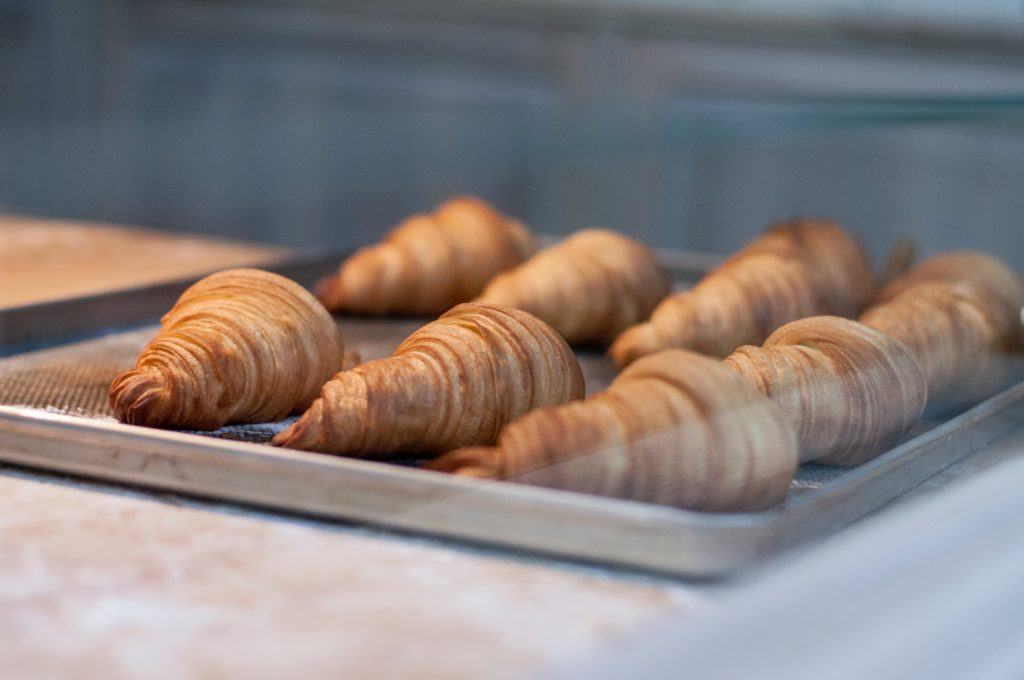Of all the breakfast pastries, few are so popular as the croissant. Who can resist the hundreds of layers of thin, delicious dough between layers upon layers of butter or margarine?
These incredible pastries can, at first glance, seem rather intimidating, but through this article, you will learn the basics, as well as the different varieties that exist!

Contents
Straight vs. Curly French Croissants
When purchasing a croissant in a restaurant, more often than not, it will come out one of two ways: straight or curly.
Now, depending on where you get it, this can mean one of two things. If you’re purchasing it in France, the shape tells you what is in the croissant itself, butter or margarine, as it is considered a major taboo to make straight croissants with anything other than butter.
The specific reason for this is unknown; however, some theorize that the butter ones were originally curved, and were changed to straight so people would be more inclined to buy the cheaper and more efficient margarine ones.
Meanwhile, in the US, it’s usually just a matter of the chef’s personal preference. The thing to keep in mind is the name.
A croissant made with butter will be called a croissant au beurre, whereas a croissant made with margarine or other such spread will be a croissant ordinaire. Both are delicious, but most recommend the former.
Of course, neither are to be confused with the equally popular pain au chocolat – which is a similar but much more decadent treat from France!

How to Make a French Croissant
Ingredients
- 2 cups of plain flour.
- 1/4 of granulated sugar.
- 2 teaspoons of powdered milk.
- 2 1/2 teaspoons of salt.
- ½ cup of unsalted butter, softened.
- 5 teaspoons of fresh yeast – or 2 ¾ teaspoons of fast action dried yeast.
- 1 cup of cold water.
- 1 cup of chilled butter.
- 1 whole egg.
Once you have all of these together, it is time to begin cooking.
Keep in mind, if you are trying to make croissant au beurres, you will want to be sure to use real butter, not any substitution, or else it won’t be the delicious concoction you’re after.
Directions
This is a long recipe but yields incredible results. Follow closely, and it will all be worth it.

- Start by placing the flour, sugar, powdered milk, salt, and salted butter in the bowl of a stand mixer that has a dough hook. Begin slowly crumbling in the yeast, being very careful to make sure the yeast doesn’t touch the salt.
- Knead at medium speed, slowly pouring in water until smooth (roughly six minutes). The dough should begin pulling away from the sides of the bowl by that point.
- On a lightly floured surface, flatten the dough into a rectangle. Cover it with cling film and chill until firm (at least two hours).
- Ten minutes before you begin again, place the chilled butter into the freezer. This will allow it to firm up and be easier to work with later.
- Take the chilled butter out and place it onto a lightly floured surface, and roll it out until it’s roughly two centimeters thick.
- Dust the chilled butter with flour. Roll out the butter into a rectangle half the size of the dough. If the butter is soft, roll it out on a sheet of parchment paper that has been lightly dusted with flour.
- Arrange the dough with a short side facing you. Place the butter on the bottom half of the dough.
- Fold the top half of the dough over the butter to enclose it completely.
- Rotate the dough clockwise 90 degrees, so that an open edge is facing you. Roll out the dough lengthwise into a rectangle two centimeters thick.
- Fold up the bottom third of the dough, so it covers one-third of the dough.
- Fold down the top third to meet the edge.
- Fold the entire dough in half to make a double turn. Press down lightly so it is smooth and even. This makes four layers of dough.
- Cover with plastic wrap and chill for one hour.
- On a lightly floured surface, arrange the dough with an open side facing you and the closed side on the right.
- Roll out again into a rectangle two centimeters thick.
- Fold the dough in thirds, like a letter. There are now three layers of dough.
- Cover with plastic wrap and chill for one hour.
- Arrange the dough on the floured work surface with an open edge facing you. Roll out the dough into a 20-inch square, one centimeter thick.
- Cut the dough in half to make two large rectangles. Drape one rectangle over a rolling pin and transfer it to a baking sheet. Cover with plastic wrap and chill.
- Using a sharp knife, cut the other rectangle into isosceles triangles with five-centimeter bases.
- Roll up the croissants, starting at the base. Push gently from the corners, rolling toward the tip, and tuck the tip underneath the croissant.
- Line two baking sheets with parchment paper.
- Arrange the croissants on the prepared baking sheets, spacing well apart, with the tips of the triangles tucked underneath so they do not unroll during baking.
- Let rise in a warm place, no hotter than 30 degrees, until doubled in size (about two hours).
- Preheat the oven to 350 F degrees.
- Lightly beat the whole egg in a cup with a fork.
- Lightly brush the puffy croissants with the egg glaze.
- Bake for 15 minutes, rotating the trays half-way through. Bake until golden.
- Transfer the croissants to a rack and let them cool.
Here’s a video showing an example of how to make a French croissant.
Conclusion
Now you have everything you need in order to make your very own croissants!
While it may be intimidating, by following the instructions, you’ll have your own croissants in no time!
Do you have any tips on baking a French croissant?
